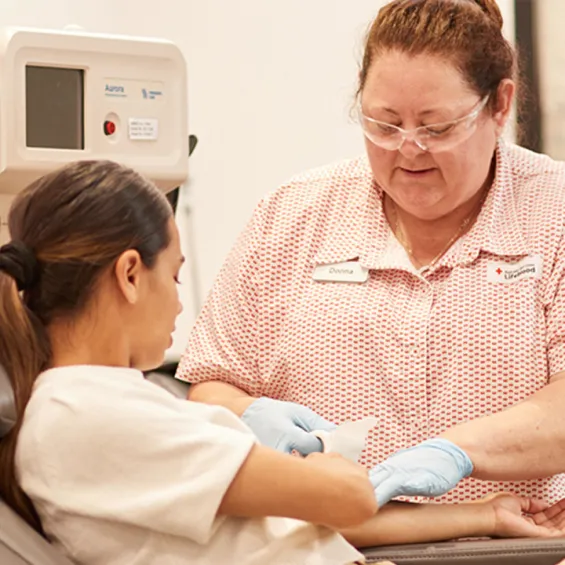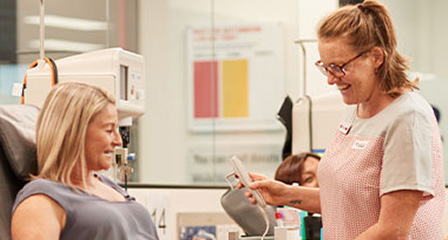Don’t have an account?
Select the donation type you’d like to make
Why we test blood
Safety is our number one priority. All of our policies and guidelines are based on the latest medical research, and what it tells us is safest for donors and patients.
The people who receive blood are often already quite sick. This makes them more likely to be infected by viruses, bacteria and other nasties, and to have a higher chance of worse outcomes if they do.
So, to protect them we do a lot of testing to make sure everything’s OK first.
By screening our donors and testing every donation, we’ve minimised the risk of receiving an infection through donated blood in Australia. In fact, it’s now considered extremely rare — a chance of less than 1 in a million.

What we test for

To start with, we test every donation for blood type to help match it to a patient.
Don't know your blood type? We’ll tell you yours soon after you’ve given for the first time.

Next, we test all donations for red cell antibodies (unless they are being used to produce plasma only). These are proteins which react with red blood cells: they’re really helpful for you, but may cause problems in a patient receiving your blood.
If the donation is for something special like an anti-D treatment, it’s tested for specific antibodies.

The screening tests look for three infectious diseases:
- HIV (AIDS virus)
- Hepatitis B
- Hepatitis C.
Some donations are also tested for human T-lymphotropic virus (HTLV), syphilis and CMV. All donations are also tested for hepatitis A virus and parvovirus B19 as part of the plasma medicines testing program. We’ll test your blood for malaria if you’ve travelled to or lived in an area where malaria is common.
If any of these tests are positive, we will notify you as soon as possible and provide you with counselling and support.
However, as these tests are only suitable for blood product screening and not to diagnose an infection in a person, any positive test must be confirmed at an external clinical laboratory. Therefore, this process takes time and you should not assume that because we have not immediately notified you after blood donation that you have tested negative.
Choosing diseases to screen and test
We use three criteria to determine what risk an infectious disease poses to patient safety.
- Whether the infectious disease is known to (or could potentially) be transmitted by blood transfusion
- How common the disease is in our population
- How severely the infection can affect patients.
We look at all the evidence and current research to work out the risk and how we should manage it. Sometimes risk factors change, so we update our rules when they do.
How we can assist with 'lookback'
If you've been diagnosed with an infection that’s possibly been transmitted through a blood transfusion, we identify, contact and test the donors whose blood was used. This process is called lookback.
Lifeblood investigates transfusions received within the last 20 years. Lookback records will routinely be maintained for 20 years, excluding those of minors which will be maintained according to state requirements.
When we investigate, we:
- obtain the transfusion record from the patient’s hospital record
- identify the blood donors who gave the blood that was transfused
- check each donor’s status for the relevant infection. This may require donor tracing and further testing.
- provide the patient’s doctor with a report of the investigation (without the identity of the donor).
If you believe you’ve acquired a blood-borne virus from a transfusion (such as hepatitis B or C), get in contact with your treating doctor as soon as possible. You or your doctor can request more information about the lookback process by emailing LookbackNational@redcrossblood.org.au or phoning the numbers below:
- New South Wales, Australian Capital Territory, Victoria and Tasmania: 1300 781 757
- South Australia, Western Australia, Northern Territory and Queensland: 07 3838 9210
Preventing risk
Over time, infectious diseases come, go, and sometimes return in a different state. When they can’t be reliably detected in tests, have no effective vaccines, or affect a large number of potential donors, they could pose a threat to the blood supply.
- Our 'surveillance framework'
Fortunately, we have what we call a ‘surveillance framework’ to keep an eye on more than 70 emerging, re-emerging and emerged infectious diseases (EREEIDs).
Lifeblood has one of the safest blood supplies in the world. The EREEID framework makes sure it stays that way. Our team actively monitors these EREEIDs and works with our own government, national and international expert groups and researchers on infectious disease developments.
The screening we have now can protect from new and emerging threats because the whole process helps stop us from collecting blood from anyone carrying an infectious disease.
- Example: Zika virus
It’s like the Zika virus outbreak a few years ago. Zika is more prevalent in countries with other mosquito-borne infections, so our existing policies already covered it and protected our blood supply. We also have a dedicated team who closely monitor emerging and existing infectious diseases.
- Why aren’t some people allowed to donate then?
Even the most sophisticated tests aren’t perfect. Many infections don’t show up in testing for a time after the person is infected — it's called the ‘window period’. Also, extremely rarely, tests can just not find an infection.
Yet, we still have to keep the people who receive blood safe. That’s why we ask eligibility questions and test to keep Australia’s blood supply as safe as possible. The questions we ask before a donor gives blood make it extremely unlikely that they have any infections when they donate.
- Other ways you can help
We understand that it can be disappointing to find out you can’t donate. The good news? There are lots of other ways you can help.




